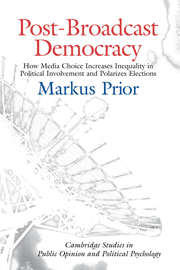 Post-Broadcast Democracy
Post-Broadcast Democracy Book contents
- Frontmatter
- Dedication
- Contents
- List of Tables
- List of Figures
- Acknowledgments
- 1 Introduction
- 2 Conditional Political Learning
- Part I The Participatory Effects of Media Choice
- Part 2 The Political Effects of Media Choice
- 6 Broadcast Television, Partisanship, and the Incumbency Advantage
- 7 Partisan Polarization in the High-Choice Media Environment
- 8 Divided by Choice: Audience Fragmentation and Political Inequality in the Post-Broadcast Media Environment
- References
- Index
- Books in the Series
6 - Broadcast Television, Partisanship, and the Incumbency Advantage
Published online by Cambridge University Press: 05 July 2014
- Frontmatter
- Dedication
- Contents
- List of Tables
- List of Figures
- Acknowledgments
- 1 Introduction
- 2 Conditional Political Learning
- Part I The Participatory Effects of Media Choice
- Part 2 The Political Effects of Media Choice
- 6 Broadcast Television, Partisanship, and the Incumbency Advantage
- 7 Partisan Polarization in the High-Choice Media Environment
- 8 Divided by Choice: Audience Fragmentation and Political Inequality in the Post-Broadcast Media Environment
- References
- Index
- Books in the Series
Summary
Just as television grew across the country and established itself as Americans' most important source of news (at least according to their own assessment), the American political scene began to experience important changes. After a period of stability in the aggregate distribution of partisanship in the 1950s and early 1960s, which Converse (1976) called a “steady-state period,” partisanship began to decline in the mid-1960s, voters became more likely to vote for different parties in presidential and congressional elections, and incumbents in Congress received more support from voters who did not identify with their party.
At least since The American Voter (Campbell et al. 1960), party identification had been considered a fundamental and highly stable component of people's political identity. It was also the most important determinant of their voting decisions. Knowing only a voter's party identification allowed scholars to predict his or her vote with remarkable accuracy. But in the mid-1960s, partisanship began to weaken. After dropping for another decade, it eventually rebounded (Bartels 2000). An explanation for these ups and downs in the importance of the most central predictor of voting behavior remains elusive. Such an explanation gains added significance because weaker impact of partisanship is often thought to go along with a greater role for individual candidates in deciding elections (and vice versa). And for better or worse, the strength of partisanship among voters is related to the salience of partisan divisions at the elite level.
- Type
- Chapter
- Information
- Post-Broadcast DemocracyHow Media Choice Increases Inequality in Political Involvement and Polarizes Elections, pp. 163 - 213Publisher: Cambridge University PressPrint publication year: 2007
